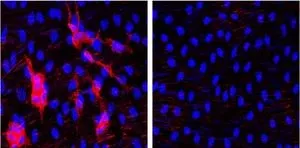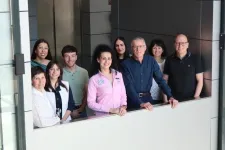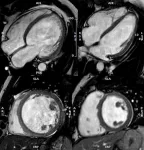(Press-News.org) Researchers at the Beckman Institute for Advanced Science and Technology developed a new technique to make ultrasound localization microscopy, an emerging diagnostic tool used for high-resolution microvascular imaging, more practical for clinical settings. Their method uses deep learning to advance in the post-processing pipeline of ULM.
Their technique, called LOcalization with Context Awareness Ultrasound Localization microscopy, or LOCA-ULM, appears in the journal Nature Communications.
“I’m really excited about making ULM faster and better so that more people will be able to use this technology. I think deep learning-based computational imaging tools will continue to play a major role in pushing the spatial and temporal resolution limits of ULM,” said first author YiRang Shin, a graduate student in the Department of Electrical and Computer Engineering at the University of Illinois Urbana-Champaign.
Looking at an ultrasound image, Shin points to a region of the brain showing strong microbubble activity from a nerve stimulation test. Credit: Elizabeth Bello, Beckman Communications Office. Ultrasound localization microscopy works by injecting microbubbles into blood vessels, where they act as contrast agents. Microbubbles are FDA-approved for clinical use. Ultrasound waves can penetrate deep tissues in the body to pinpoint the location of these microbubbles — each only several microns in size — as they travel through the bloodstream. Researchers use microbubbles to track blood flow speed and create spatial images of blood vessels at the microscale.
The current imaging speed of ULM has limited its practical application as a diagnostic tool in the medical field and a research tool in basic science. Increasing imaging speed requires a higher concentration of microbubbles in the bloodstream, which makes the post-processing much more difficult, Shin said.
The researchers’ new method demonstrates higher imaging performance and processing speed, increased sensitivity for functional ULM and overall superior in vivo imaging. It also demonstrates improved computational and microbubble localization performance and is adaptable to different microbubble concentrations.
“It really beats conventional microbubble localization methods; this is the way to go,” said Pengfei Song, a Beckman researcher and the Y.T. Lo Faculty Fellow and assistant professor of electrical and computer engineering at Illinois.
To make microbubble localization faster, more accurate and more efficient, the researchers developed a simulation model based on a generative adversarial network called GAN. This simulation creates realistic microbubble signals to train the deep context-aware neural network DECODE.
Editor’s note:
The paper titled “Context-aware deep learning enables high-efficiency localization of high concentration microbubbles for super-resolution ultrasound localization microscopy” can be accessed at: https://doi.org/10.1038/s41467-024-47154-2
Pengfei Song is also an assistant professor of bioengineering and biomedical and translational sciences and an affiliate of the Carl R. Woese Institute for Genomic Biology at Illinois.
Additional coauthors include Matthew R. Lowerison, Yike Wang, Xi Chen, Qi You, Zhijie Dong and Mark A. Anastasio. For full author information, please consult the publication.
Media contact: Jenna Kurtzweil, kurtzwe2@illinois.edu
END
Advancing high-resolution ultrasound imaging with deep learning
Ultrasound, ultraprecise
2024-04-22
ELSE PRESS RELEASES FROM THIS DATE:
New study confirms community pharmacies can help people quit smoking
2024-04-22
A new study shows community pharmacies may play a key role in helping people quit smoking.
The findings came out in the article Closing the Tobacco Treatment Gap, published in the 10th anniversary special issue of Pharmacy. The results provide valuable insights into the implementation of tobacco cessation services within community pharmacies while identifying barriers to further improvements.
Tobacco use remains a leading preventable cause of death. Although two thirds of people who smoke would like to quit, many individuals trying to quit on their own are not successful. To address this gap, the study explored how ...
Book aims to re-design the up-skilling game. Rotman School author says we need a re-set in the way we think about human skill in the genAI era
2024-04-22
April 22, 2024
Book Aims to Re-Design the Up-Skilling Game. Rotman School Author Says We Need a Re-Set in the Way We Think About Human Skill in the GenAI era
Toronto – Although communicative and relational skills are currently in the greatest demand in organizations large and small, we are as educators, executives, and talent developers very far away from the kind of precision in identifying, measuring, selecting, and developing these skills that we have achieved with cognitive and technical skills. At the same time, the automation ...
Could automation, electrification of long-haul trucking reduce environmental impacts?
2024-04-22
April 22, 2024
Contact: Lori Atherton, SEAS, lorather@umich.edu
Jim Erickson, Michigan News, ericksn@umich.edu
A new University of Michigan study finds that automation and electrification of long-haul trucking can reduce urban health impacts and environmental damages.
For long-haul routes below 300 miles, electrification can reduce air pollution and greenhouse gas damages by 13%, or $587 million annually, according to the study. ...
European union should adopt a research-based approach to ensure the quality and safety of substances of human origin
2024-04-22
April 22, 2024
European Union Should Adopt a Research-Based Approach to Ensure the Quality and Safety of Substances of Human Origin
London/Toronto – Substances of human origin (SoHOs) such as blood, plasma, skin, corneas, and embryos play an increasing role in life-saving medical procedures. Governments around the world are reevaluating their healthcare policies to ensure of a supply of SoHOs for their population, while also considering the best-interests of both donors and patients.
A ...
Study identifies signs of repeated blast-related brain injury in active-duty United States Special Operations Forces
2024-04-22
Repeated exposure to explosive blasts has the potential to cause brain injuries, but there is currently no diagnostic test for these injuries
In a study of 30 active-duty United States SOF personnel, researchers found that increased blast exposure was associated with structural, functional, and neuroimmune changes to the brain and a decline in health-related quality of life
The researchers are now designing a larger study to develop a diagnostic test for repeated blast brain injury
United States (US) Special Operations Forces (SOF) personnel are frequently exposed to explosive blasts during training and combat. However, ...
Mount Sinai scientists discover the cellular functions of a family of proteins integral to inflammatory diseases
2024-04-22
New York, NY (April 22, 2024) – In a scientific breakthrough, Mount Sinai researchers have revealed the biological mechanisms by which a family of proteins known as histone deacetylases (HDACs) activate immune system cells linked to inflammatory bowel disease (IBD) and other inflammatory diseases.
This discovery, reported in Proceedings of the National Academy of Sciences (PNAS), could potentially lead to the development of selective HDAC inhibitors designed to treat types of IBD such as ulcerative colitis and Crohn’s disease.
“Our understanding of the specific function of class II HDACs in different cell types has been limited, impeding ...
Spanish scientists identify the key cell type for strategies to prevent atherosclerosis in progeria syndrome
2024-04-22
Hutchinson-Gilford progeria syndrome (HGPS) is an extremely rare genetic disease that affects just 1 in every 20 million people; it is estimated that fewer than 400 children in the world have the disease. HGPS is characterized by accelerated aging, severe atherosclerosis, and premature death at an average age of about 15 years. Although people with HGPS do not normally have conventional cardiovascular risk factors (hypercholesterolemia, obesity, smoking, etc.), most patients die from the complications of atherosclerosis: myocardial ...
A new Spanish study provides the first stratification of the risk of developing dilated cardiomyopathy among symptom-free genetic carriers
2024-04-22
Dilated cardiomyopathy is the most frequent cause of heart failure in young people and is the leading cause of heart transplantation. In this disease, the heart enlarges and reduces its capacity to pump blood. People with dilated cardiomyopathy are at high risk for arrhythmias and sudden death.
In approximately 30%–40% of people with dilated cardiomyopathy, the disease is caused by a genetic mutation. When a genetic cause is identified, the patient’s family members can be studied to determine if they have also inherited the altered gene.
Family members who are carriers of the genetic mutation are at risk for developing the disease in ...
International Lawyer from the University of Warwick calls for fairness in WHO Pandemic Treaty Talks
2024-04-22
As the World Health Organization (WHO) pushes for countries to seal the Pandemic Treaty by May this year, researchers at the University of Warwick and Kings College London stress the need for fair negotiations.
The opinion piece, featured in PLOS Global Public Health journal, is led by Professor Sharifah Sekalala . The team highlights the importance of considering "Time Equity" in these talks, urging caution on setting deadlines and sharing the burden when time is tight.
Since COVID-19 hit, demands for health equity ...
International Society for Autism Research (INSAR) 23rd Annual Meeting to be held in Melbourne, Australia May 15-18, 2024
2024-04-22
The International Society for Autism Research (INSAR) will hold its 2024 Annual Meeting – the organization’s 23rd – from Wednesday, May 15 through Saturday, May 18, 2024, bringing together a global, multidisciplinary group of more than 1,200 autism researchers, clinicians, advocates, self-advocates, and students from 20 countries to exchange the latest scientific learnings and discoveries that are advancing the expanding understanding of autism and its complexities. This year’s ...
LAST 30 PRESS RELEASES:
American College of Cardiology announces Fuster Prevention Forum
AAN issues new guideline for the management of functional seizures
Could GLP-1 drugs affect risk of epilepsy for people with diabetes?
New circoviruses discovered in pilot whales and orcas from the North Atlantic
Study finds increase in risk of binge drinking among 12th graders who use 2 or more cannabis products
New paper-based technology could transform cancer drug testing
Opioids: clarifying the concept of safe supply to save lives
New species of tiny pumpkin toadlet discovered in Brazil highlights need for conservation in the mountain forests of Serra do Quiriri
Reciprocity matters--people were more supportive of climate policies in their country if they believed other countries were making significant efforts themselves
Stanford Medicine study shows why mRNA-based COVID-19 vaccines can cause myocarditis
Biobanking opens new windows into human evolution
Sky-high smoke
AI tips off scientists to new drug target to fight, treat mpox
USC researchers develop next-generation CAR T cells that show stronger, safer response in animal models
New study reveals Industrial Revolution’s uneven health impacts across England
Vine-inspired robotic gripper gently lifts heavy and fragile objects
Fingerprint of ancient seafarer found on Scandinavia’s oldest plank boat
Lunar soil analyses reveal how space weathering shapes the Moon’s ultraviolet reflectance
Einstein’s theory comes wrapped up with a bow: astronomers spot star “wobbling” around black hole
Danforth Plant Science Center to lead multi-disciplinary research to enhance stress resilience in bioenergy sorghum
Home-delivered groceries improve blood sugar control for people with diabetes facing food insecurity
MIT researchers identified three cognitive skills we use to infer what someone really means
The Iberian Peninsula is rotating clockwise according to new geodynamic data
SwRI, Trinity University to study stable bacterial proteins in search of medical advances
NIH-led study reveals role of mobile DNA elements in lung cancer progression
Stanford Medicine-led study identifies immune switch critical to autoimmunity, cancer
Research Alert: How the Immune System Stalls Weight Loss
Glucagon-like peptide 1 receptor agonist use and vertebral fracture risk in type 2 diabetes
Nonadherence to cervical cancer screening guidelines in commercially insured US adults
Contraception and castration linked to longer lifespan
[Press-News.org] Advancing high-resolution ultrasound imaging with deep learningUltrasound, ultraprecise






